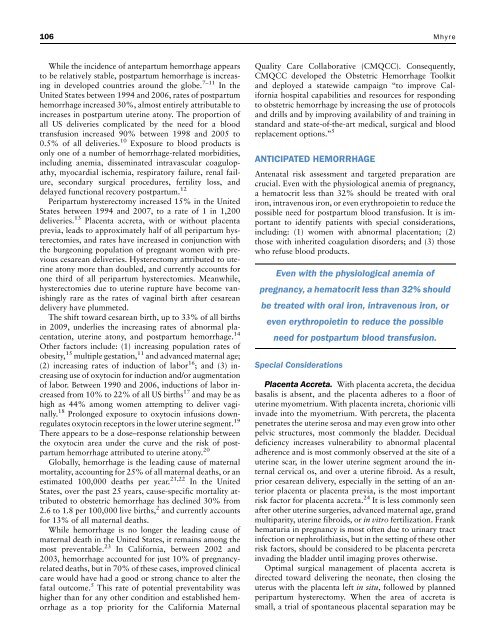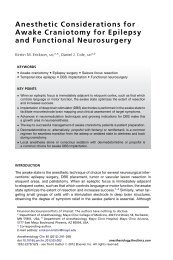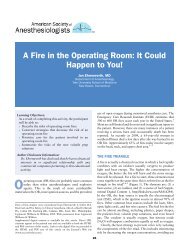14 Postpartum Hemorrhage on Labor and Delivery.pdf - Vtr
14 Postpartum Hemorrhage on Labor and Delivery.pdf - Vtr
14 Postpartum Hemorrhage on Labor and Delivery.pdf - Vtr
You also want an ePaper? Increase the reach of your titles
YUMPU automatically turns print PDFs into web optimized ePapers that Google loves.
106 Mhyre<br />
While the incidence of antepartum hemorrhage appears<br />
to be relatively stable, postpartum hemorrhage is increasing<br />
in developed countries around the globe. 7–11 In the<br />
United States between 1994 <strong>and</strong> 2006, rates of postpartum<br />
hemorrhage increased 30%, almost entirely attributable to<br />
increases in postpartum uterine at<strong>on</strong>y. The proporti<strong>on</strong> of<br />
all US deliveries complicated by the need for a blood<br />
transfusi<strong>on</strong> increased 90% between 1998 <strong>and</strong> 2005 to<br />
0.5% of all deliveries. 10 Exposure to blood products is<br />
<strong>on</strong>ly <strong>on</strong>e of a number of hemorrhage-related morbidities,<br />
including anemia, disseminated intravascular coagulopathy,<br />
myocardial ischemia, respiratory failure, renal failure,<br />
sec<strong>on</strong>dary surgical procedures, fertility loss, <strong>and</strong><br />
delayed functi<strong>on</strong>al recovery postpartum. 12<br />
Peripartum hysterectomy increased 15% in the United<br />
States between 1994 <strong>and</strong> 2007, to a rate of 1 in 1,200<br />
deliveries. 13 Placenta accreta, with or without placenta<br />
previa, leads to approximately half of all peripartum hysterectomies,<br />
<strong>and</strong> rates have increased in c<strong>on</strong>juncti<strong>on</strong> with<br />
the burge<strong>on</strong>ing populati<strong>on</strong> of pregnant women with previous<br />
cesarean deliveries. Hysterectomy attributed to uterine<br />
at<strong>on</strong>y more than doubled, <strong>and</strong> currently accounts for<br />
<strong>on</strong>e third of all peripartum hysterectomies. Meanwhile,<br />
hysterectomies due to uterine rupture have become vanishingly<br />
rare as the rates of vaginal birth after cesarean<br />
delivery have plummeted.<br />
The shift toward cesarean birth, up to 33% of all births<br />
in 2009, underlies the increasing rates of abnormal placentati<strong>on</strong>,<br />
uterine at<strong>on</strong>y, <strong>and</strong> postpartum hemorrhage. <str<strong>on</strong>g>14</str<strong>on</strong>g><br />
Other factors include: (1) increasing populati<strong>on</strong> rates of<br />
obesity, 15 multiple gestati<strong>on</strong>, 11 <strong>and</strong> advanced maternal age;<br />
(2) increasing rates of inducti<strong>on</strong> of labor 16 ; <strong>and</strong> (3) increasing<br />
use of oxytocin for inducti<strong>on</strong> <strong>and</strong>/or augmentati<strong>on</strong><br />
of labor. Between 1990 <strong>and</strong> 2006, inducti<strong>on</strong>s of labor increased<br />
from 10% to 22% of all US births 17 <strong>and</strong> may be as<br />
high as 44% am<strong>on</strong>g women attempting to deliver vaginally.<br />
18 Prol<strong>on</strong>ged exposure to oxytocin infusi<strong>on</strong>s downregulates<br />
oxytocin receptors in the lower uterine segment. 19<br />
There appears to be a dose–resp<strong>on</strong>se relati<strong>on</strong>ship between<br />
the oxytocin area under the curve <strong>and</strong> the risk of postpartum<br />
hemorrhage attributed to uterine at<strong>on</strong>y. 20<br />
Globally, hemorrhage is the leading cause of maternal<br />
mortality, accounting for 25% of all maternal deaths, or an<br />
estimated 100,000 deaths per year. 21,22 In the United<br />
States, over the past 25 years, cause-specific mortality attributed<br />
to obstetric hemorrhage has declined 30% from<br />
2.6 to 1.8 per 100,000 live births, 2 <strong>and</strong> currently accounts<br />
for 13% of all maternal deaths.<br />
While hemorrhage is no l<strong>on</strong>ger the leading cause of<br />
maternal death in the United States, it remains am<strong>on</strong>g the<br />
most preventable. 23 In California, between 2002 <strong>and</strong><br />
2003, hemorrhage accounted for just 10% of pregnancyrelated<br />
deaths, but in 70% of these cases, improved clinical<br />
care would have had a good or str<strong>on</strong>g chance to alter the<br />
fatal outcome. 5 This rate of potential preventability was<br />
higher than for any other c<strong>on</strong>diti<strong>on</strong> <strong>and</strong> established hemorrhage<br />
as a top priority for the California Maternal<br />
Quality Care Collaborative (CMQCC). C<strong>on</strong>sequently,<br />
CMQCC developed the Obstetric <str<strong>on</strong>g>Hemorrhage</str<strong>on</strong>g> Toolkit<br />
<strong>and</strong> deployed a statewide campaign ‘‘to improve California<br />
hospital capabilities <strong>and</strong> resources for resp<strong>on</strong>ding<br />
to obstetric hemorrhage by increasing the use of protocols<br />
<strong>and</strong> drills <strong>and</strong> by improving availability of <strong>and</strong> training in<br />
st<strong>and</strong>ard <strong>and</strong> state-of-the-art medical, surgical <strong>and</strong> blood<br />
replacement opti<strong>on</strong>s.’’ 5<br />
ANTICIPATED HEMORRHAGE<br />
Antenatal risk assessment <strong>and</strong> targeted preparati<strong>on</strong> are<br />
crucial. Even with the physiological anemia of pregnancy,<br />
a hematocrit less than 32% should be treated with oral<br />
ir<strong>on</strong>, intravenous ir<strong>on</strong>, or even erythropoietin to reduce the<br />
possible need for postpartum blood transfusi<strong>on</strong>. It is important<br />
to identify patients with special c<strong>on</strong>siderati<strong>on</strong>s,<br />
including: (1) women with abnormal placentati<strong>on</strong>; (2)<br />
those with inherited coagulati<strong>on</strong> disorders; <strong>and</strong> (3) those<br />
who refuse blood products.<br />
Even with the physiological anemia of<br />
pregnancy, a hematocrit less than 32% should<br />
be treated with oral ir<strong>on</strong>, intravenous ir<strong>on</strong>, or<br />
even erythropoietin to reduce the possible<br />
need for postpartum blood transfusi<strong>on</strong>.<br />
Special C<strong>on</strong>siderati<strong>on</strong>s<br />
Placenta Accreta. With placenta accreta, the decidua<br />
basalis is absent, <strong>and</strong> the placenta adheres to a floor of<br />
uterine myometrium. With placenta increta, chori<strong>on</strong>ic villi<br />
invade into the myometrium. With percreta, the placenta<br />
penetrates the uterine serosa <strong>and</strong> may even grow into other<br />
pelvic structures, most comm<strong>on</strong>ly the bladder. Decidual<br />
deficiency increases vulnerability to abnormal placental<br />
adherence <strong>and</strong> is most comm<strong>on</strong>ly observed at the site of a<br />
uterine scar, in the lower uterine segment around the internal<br />
cervical os, <strong>and</strong> over a uterine fibroid. As a result,<br />
prior cesarean delivery, especially in the setting of an anterior<br />
placenta or placenta previa, is the most important<br />
risk factor for placenta accreta. 24 It is less comm<strong>on</strong>ly seen<br />
after other uterine surgeries, advanced maternal age, gr<strong>and</strong><br />
multiparity, uterine fibroids, or in vitro fertilizati<strong>on</strong>. Frank<br />
hematuria in pregnancy is most often due to urinary tract<br />
infecti<strong>on</strong> or nephrolithiasis, but in the setting of these other<br />
risk factors, should be c<strong>on</strong>sidered to be placenta percreta<br />
invading the bladder until imaging proves otherwise.<br />
Optimal surgical management of placenta accreta is<br />
directed toward delivering the ne<strong>on</strong>ate, then closing the<br />
uterus with the placenta left in situ, followed by planned<br />
peripartum hysterectomy. When the area of accreta is<br />
small, a trial of sp<strong>on</strong>taneous placental separati<strong>on</strong> may be




